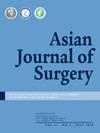Safety and efficacy of the amino acid-crosslinked hyaluronic acid in the treatment of temple hollowing
IF 3.5
3区 医学
Q1 SURGERY
引用次数: 0
Abstract
Background
Loss of volume in the temples is an early sign of aging and often gives the impression of a gaunt and emaciated appearance.
Objective
The authors conduct a clinical study to investigate the safety and effectiveness of the amino acid crosslinked hyaluronic acid (ACHA) for the treatment of temple hollowing.
Methods
75 subjects with Temple Hollowing Scale (THS) from 2 to 4 were enrolled and assigned according to the ratio of 2 (ACHA group, n = 50): 1 (no treatment control group, n = 25). All subjects were assessed at the 12-month follow-up visit using the THS, Global Aesthetic Improvement Scale (GAIS), ultrasound, and three-dimensional scanning. Subjects were instructed to report any adverse events (AEs) within 14 days after the ACHA treatment.
Results
An average volume of 4.72 ± 1.13 ml was injected into the temples. We received 18 treatment-related AEs reported by 10 subjects. Compared with the control group, THS, GAIS, and soft tissue thickness were significantly improved in the ACHA group at 1 month, 6, and 12 months after injection. Three-dimensional scanning showed that ACHA could maintain a certain volume in the temple 12 months after ACHA injection.
Conclusions
ACHA is an effective and safe hyaluronic acid for patients with minimal to severe temple hollowing.
氨基酸交联透明质酸治疗太阳穴凹陷的安全性和有效性。
背景:太阳穴凹陷是衰老的早期征兆,通常会给人一种憔悴憔悴的感觉:作者开展了一项临床研究,以探讨氨基酸交联透明质酸(ACHA)治疗太阳穴凹陷的安全性和有效性。方法:招募 75 名太阳穴凹陷量表(THS)为 2 至 4 的受试者,并按照 2(ACHA 组,n = 50)、1(无治疗对照组,n = 25)和 1(无治疗对照组,n = 25)的比例进行分配:1(无治疗对照组,n = 25)的比例分配。所有受试者都在 12 个月的随访中接受了 THS、全球美学改善量表 (GAIS)、超声波和三维扫描评估。受试者被要求在ACHA治疗后14天内报告任何不良事件(AEs):太阳穴平均注射量为 4.72 ± 1.13 毫升。我们收到了 10 名受试者报告的 18 例与治疗相关的 AE。与对照组相比,ACHA组在注射后1个月、6个月和12个月的THS、GAIS和软组织厚度均有明显改善。三维扫描显示,注射ACHA后12个月,ACHA能在太阳穴内保持一定的体积:ACHA是一种有效且安全的透明质酸,适用于轻度至重度太阳穴凹陷的患者。
本文章由计算机程序翻译,如有差异,请以英文原文为准。
求助全文
约1分钟内获得全文
求助全文
来源期刊

Asian Journal of Surgery
医学-外科
CiteScore
3.60
自引率
31.40%
发文量
1589
审稿时长
33 days
期刊介绍:
Asian Journal of Surgery, launched in 1978, is the official peer-reviewed open access journal of the Asian Surgical Association, the Taiwan Robotic Surgery Association, and the Taiwan Society of Coloproctology. The Journal is published monthly by Elsevier and is indexed in SCIE, Medline, ScienceDirect, Scopus, Embase, Current Contents, PubMed, Current Abstracts, BioEngineering Abstracts, SIIC Data Bases, CAB Abstracts, and CAB Health.
ASJSUR has a growing reputation as an important medium for the dissemination of cutting-edge developments in surgery and its related disciplines in the Asia-Pacific region and beyond. Studies on state-of-the-art surgical innovations across the entire spectrum of clinical and experimental surgery are particularly welcome.
The journal publishes original articles, review articles, and case reports that are of exceptional and unique importance. The journal publishes original articles, review articles, and case reports that are of exceptional and unique importance.
 求助内容:
求助内容: 应助结果提醒方式:
应助结果提醒方式:


